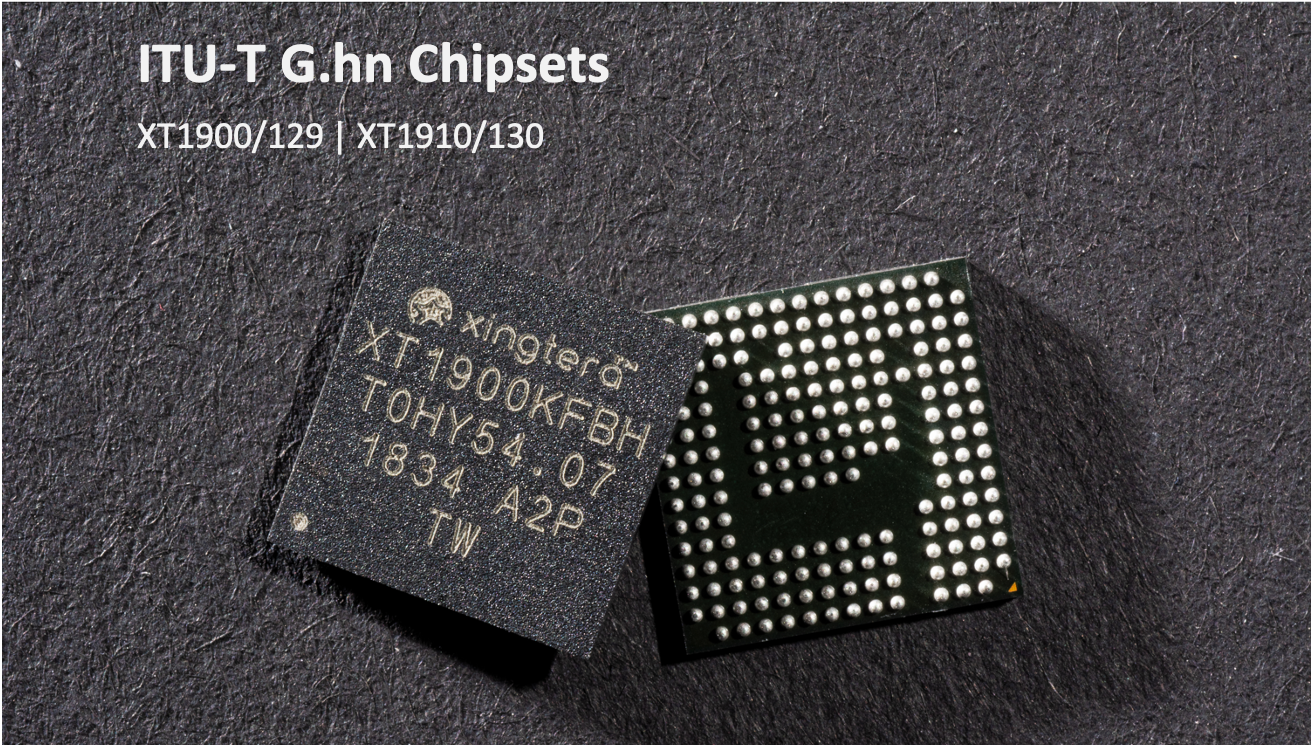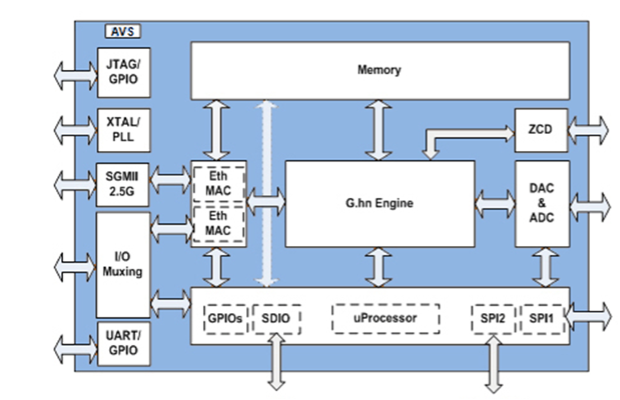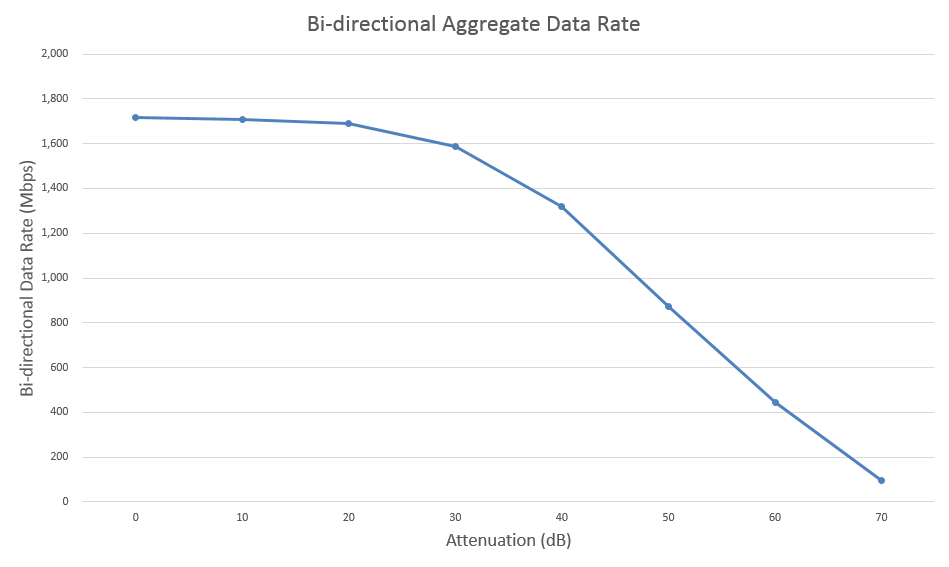XT1900/129 | XT1910/130
ITU-T G.9960/9961 compatible for ultra-high speed backbone applications over any 2-wires.
Xingtera’s G.hn (Ghn) chipsets and solutions are designed to comply with the ITU-T G.hn standards, the family of wired communication and home networking specifications developed under the International Telecommunication Union’s Standardization arm (ITU-T) and promoted by the HomeGrid Forum along with several other organizations. The G.hn specification defines ultra-high-speed networking over power lines, phone lines and coaxial cables with data rates up to 2,000Mbps. It is a complementary counterpart to WiFi technologies because G.hn chips provide a better way for Internet coverage throughout the house based on existing wires. The G.hn series chipsets can be applied as power-line communication (PLC) chipsets, Ethernet over Coax (EoC) chipsets, or IP over 2-Wire chipsets.


The XT1000 Series (XT1900/XT1910) chipsets are Xingtera’s G.hn (Ghn) based, high performance, carrier-grade chip product line. The chipsets are fully compliant to the ITU-T G.hn standards, with support of multiple media including coax cables, power-lines, phone lines, twisted-pair cables, and other copper wires. The XT1000 series chipsets are capable of running ITU-T G.hn compliant 100MHz MIMO (XT1900 as power-lines communication chipsets) and 200MHz SISO (XT1910 as Ethernet over Coax or IP over 2-Wire chipsets) bandplans. The maximum PHY rate is 2Gbps, while the maximum throughput can reach 1.7Gbps. Currently all the chipsets are Wave-2 generation.
The XT1000 series chipsets can be used to build various G.hn-enabled home networking or access networking products: power-line communication (PLC) adapters, Ethernet and WiFi extenders (over power-line, coax, or phone line), G.hn + Mesh WiFi devices, home gateways, set-top boxes (STB), home entertainment systems, network-attached storage devices (NAS), HDTVs, home security surveillance systems, digital signage, healthcare networking systems, gaming consoles, desktop PCs, etc. Compared to legacy power-line communication chipsets, Xingtera’s G.hn chipsets provide higher PHY data rates and stronger stability. Xingtera also offers turn-key solutions with software or module level customization to further accelerate the time to market for customers.
G.hn Chipset Features
G.hn Chipset Specifications
- G.hn (Ghn) home network controller with RGMII interface for Ethernet connection
- G.hn Wave-1 and Wave-2 (XT1900/XT1910) both available
- Support LDPC with full FEC rate and Low Complicity Profile (LCP)
- Traffic classification: L2-4 header classification and flow-based analysis in HW
- 128-bit AES-CCM security with pair-wise keying and PAK support
- 1K-entry, 4-way associative MAC table supporting unicast and multicast addresses
- 4K–entry single tag/ double tag VLAN support
- IGMP v2/v3 and MLD v1/v2 support
- Stable Ethernet traffic with guaranteed BW & latency, time-stamping & synchronization
- Optional DDR2/DDR3 interface for packet buffering and CPU instruction & data storage
G.hn Chipset Performance
The following picture showcases the bi-directional aggregate data rate under different attenuation (0 – 70 dB), tested using a Spirent TestCenter. The aggregate data rate is calculated by adding the downstream and upstream data rates together.

G.hn Chipset Software Service
Extended Offerings
We design, build and support broadband PLC devices for clients worldwide. We make your business stand out.
G.hn Modules
Xingtera offers a wide range of G.hn modules (Ghn modules) based on our chipsets and technologies. These G.hn modules are designed to have minimum footprint for easy integration to host or client devices. The MOD957 G.hn module supports 100MHz bandplan and 1,000Mbps PHY rate, while the MOD958 G.hn modulesupports 200MHz bandplan and 2,000Mbps PHY rate.
G.hn Devices
Xingtera and its partners offer several options of G.hn (Ghn) chipset based adapters or devices, including G.hn power-line adapters and G.hn + WiFi routers.
View All DevicesCustomization Services
We provide customization services based on G.hn chipsets and solutions, to fully meet your unique applications and requirements. Both G.hn Wave-1 and Wave-2 technologies are available, depending on specific customer requirements. We will select the best power-line communication, Ethernet over Coax, Ethernet over Phone-Line, or IP over 2-Wire chipsets or modules tailored for your applications.
More informations about G.hn
G.hn Applications
G.hn Standards
The G.hn standard (Ghn) is a suite of specifications for home networking chips and devices with data rates up to 2 Gbps and operation over different types of copper wires, including telephone wiring (phone lines), coaxial cables (coax cables), power-lines and twisted-pair cables (UTP/2-Wire). A single G.hn wired communication or home network device is able to provide multi-node Ethernet communication and connectivity over any of the supported home wire types. Some benefits of a multi-wire standard include lower equipment development costs and lower deployment costs for service providers (by enabling very easy self-installation by end customers).
The G.hn standards and chips support multiple profiles for optimal performance over different media. The profiles include power-line, phone line, and coax cables. There are also multiple band plans in each profile. For details please refer to the picture on the right.
The G.hn standard is developed under the International Telecommunication Union’s Standardization arm (ITU-T) and promoted by the HomeGrid Forum along with global telecom carriers, semiconductor companies, system vendors, academic institutes. ITU-T Recommendation G.9960 was approved on October 9, 2009, specifying the physical layers and the architecture of the standard. Recommendation G.9961 (the Data Link Layer) was later approved on June 11, 2010. The ITU-T extended the technology with multiple-input, multiple-output (MIMO) technology to increase data rates and signaling distance over power-line, with the approved G.9963 Recommendation in March 2012. Amendments to the main G.9960/G.9961 added new functionalities to the base standard, including neighboring domains interference mitigation (distributed NDIM), power-saving modes, PSD management, new transmission profiles, and Layer 2 configuration management protocol LCMP.
G.hn specifies a single physical layer based on fast Fourier transform (FFT) orthogonal frequency-division multiplexing (OFDM) modulation and low-density parity-check code (LDPC) forward error correction (FEC) code. G.hn includes the capability to notch specific frequency bands to avoid interference with amateur radio bands and other licensed radio services. G.hn includes mechanisms to avoid interference with legacy home networking technologies and also with other wireline systems such as VDSL2 or other types of DSL used to access the home. OFDM systems split the transmitted signal into multiple orthogonal sub-carriers, and each one of the sub-carriers is modulated using QAM. The maximum QAM constellation supported is 4096-QAM (12-bit QAM).
The G.hn Media Access Control is based on a time division multiple access (TDMA) architecture, in which a “domain master” schedules Transmission Opportunities (TXOPs) that can be used by one or more devices in the “domain”. There are two types of TXOPs, Contention-Free Transmission Opportunities (CFTXOP) and Shared Transmission Opportunities (STXOP). The CFTXOPs have a fixed duration and are allocated to a specific pair of transmitter and receiver. CFTXOP are used for implementing TDMA Channel Access for specific applications that require quality of service (QoS) guarantees. The STXOPs are shared among multiple devices in the network. STXOP are divided into Time Slots (TS). There are two types of TS: Contention-Free Time Slots (CFTS) for implementing “implicit” token passing Channel Access. In G.hn, a series of consecutive CFTS is allocated to a number of devices. The allocation is performed by the “domain master” and broadcast to all nodes in the network. There are pre-defined rules that specify which device can transmit after another device has finished using the channel; and Contention-Based Time Slots (CBTS) for implementing CSMA/CARP Channel Access. In general, CSMA systems cannot completely avoid collisions, so CBTS are only useful for applications that do not have strict Quality of Service requirements.
G.hn technology is a complementary counterpart to WiFi because it can enable a reliable high-speed Internet backhaul based on existing home wires. Although WiFi technology is popular for consumer home networks, G.hn is an adequate supplementary solution for consumers in situations in which WiFi is not needed (for example, to connect a stationary device like a TV or a network-attached storage device), not desired (due to security concerns), or not feasible (for example, due to limited range, poor performance, or instability of wireless signals).
For more information regarding the G.hn standards and technologies, please visit G.hn Standards.